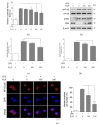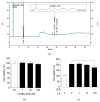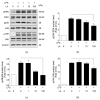Anti-Inflammatory Effects of Fermented Lotus Root and Linoleic Acid in Lipopolysaccharide-Induced RAW 264.7 Cells
- PMID: 33228085
- PMCID: PMC7699317
- DOI: 10.3390/life10110293
Anti-Inflammatory Effects of Fermented Lotus Root and Linoleic Acid in Lipopolysaccharide-Induced RAW 264.7 Cells
Abstract
Inflammation is a protective response of the innate immune system. However, aberrant inflammatory responses lead to various diseases. Lotus root, the edible rhizome of Nelumbo nucifera, is a popular traditional herbal medicine in East Asia. In a previous study, we reported that fermented lotus root (FLR) alleviated ethanol/HCl-induced gastric ulcers in rats by modulating inflammation-related genes. However, the mechanisms underlying the anti-inflammatory effects of FLR and its major constituent, linoleic acid (LA), are still largely unknown. In this study, we investigated the anti-inflammatory effects of FLR and LA on lipopolysaccharide (LPS)-induced inflammation in RAW 264.7 murine macrophages. We found that FLR inhibited LPS-induced expression of inflammatory mediators through down-regulation of NF-κB activity. Similarly, LA also attenuated LPS-induced inflammatory responses and reduced LPS-induced phosphorylation of proteins associated with NF-κB signaling, such as ERK, JNK, and p38. Overall, our results suggested that FLR and LA may effectively ameliorate inflammatory diseases.
Keywords: MAPK; NF-κB; anti-inflammatory effect; fermented lotus root.
Conflict of interest statement
The authors declare no conflict of interest.
Figures







Similar articles
-
Lotus leaf (Nelumbo nucifera) and its active constituents prevent inflammatory responses in macrophages via JNK/NF-κB signaling pathway.Am J Chin Med. 2014;42(4):869-89. doi: 10.1142/S0192415X14500554. Am J Chin Med. 2014. PMID: 25004880
-
Xanthii fructus inhibits inflammatory responses in LPS-stimulated RAW 264.7 macrophages through suppressing NF-κB and JNK/p38 MAPK.J Ethnopharmacol. 2015 Dec 24;176:394-401. doi: 10.1016/j.jep.2015.11.020. Epub 2015 Nov 10. J Ethnopharmacol. 2015. PMID: 26560439
-
Lotus (Nelumbo nucifera) seed protein isolate exerts anti-inflammatory and antioxidant effects in LPS-stimulated RAW264.7 macrophages via inhibiting NF-κB and MAPK pathways, and upregulating catalase activity.Int J Biol Macromol. 2019 Aug 1;134:791-797. doi: 10.1016/j.ijbiomac.2019.05.094. Epub 2019 May 18. Int J Biol Macromol. 2019. PMID: 31112732
-
Anti-inflammatory activity of 4-methoxyhonokiol is a function of the inhibition of iNOS and COX-2 expression in RAW 264.7 macrophages via NF-kappaB, JNK and p38 MAPK inactivation.Eur J Pharmacol. 2008 May 31;586(1-3):340-9. doi: 10.1016/j.ejphar.2008.02.044. Epub 2008 Feb 26. Eur J Pharmacol. 2008. PMID: 18378223
-
4-methoxycinnamyl p-coumarate isolated from Etlingera pavieana rhizomes inhibits inflammatory response via suppression of NF-κB, Akt and AP-1 signaling in LPS-stimulated RAW 264.7 macrophages.Phytomedicine. 2019 Feb 15;54:89-97. doi: 10.1016/j.phymed.2018.09.193. Epub 2018 Sep 18. Phytomedicine. 2019. PMID: 30668386
Cited by
-
Exopolysaccharides of Lactobacillus rhamnosus GG ameliorate Salmonella typhimurium-induced intestinal inflammation via the TLR4/NF-κB/MAPK pathway.J Anim Sci Biotechnol. 2023 Mar 6;14(1):23. doi: 10.1186/s40104-023-00830-7. J Anim Sci Biotechnol. 2023. PMID: 36872332 Free PMC article.
-
Long Chain Fatty Acids as Modulators of Immune Cells Function: Contribution of FFA1 and FFA4 Receptors.Front Physiol. 2021 Jul 1;12:668330. doi: 10.3389/fphys.2021.668330. eCollection 2021. Front Physiol. 2021. PMID: 34276398 Free PMC article. Review.
-
Preventive Effect of Arctium lappa Polysaccharides on Acute Lung Injury through Anti-Inflammatory and Antioxidant Activities.Nutrients. 2023 Nov 29;15(23):4946. doi: 10.3390/nu15234946. Nutrients. 2023. PMID: 38068804 Free PMC article.
-
Effects of black soldier fly larvae as protein or fat sources on apparent nutrient digestibility, fecal microbiota, and metabolic profiles in beagle dogs.Front Microbiol. 2022 Nov 25;13:1044986. doi: 10.3389/fmicb.2022.1044986. eCollection 2022. Front Microbiol. 2022. PMID: 36504773 Free PMC article.
-
Lactobacillus plantarum ATG-K2 and ATG-K6 Ameliorates High-Fat with High-Fructose Induced Intestinal Inflammation.Int J Mol Sci. 2021 Apr 24;22(9):4444. doi: 10.3390/ijms22094444. Int J Mol Sci. 2021. PMID: 33923142 Free PMC article.
References
-
- De Lavor E.M., Fernandes A.W.C., de Andrade Teles R.B., Leal A., de Oliveira Junior R.G., Gama E.S.M., de Oliveira A.P., Silva J.C., de Moura Fontes Araujo M.T., Coutinho H.D.M., et al. Essential Oils and Their Major Compounds in the Treatment of Chronic Inflammation: A Review of Antioxidant Potential in Preclinical Studies and Molecular Mechanisms. Oxid. Med. Cell. Longev. 2018;2018:6468593. doi: 10.1155/2018/6468593. - DOI - PMC - PubMed
-
- Lu S., Wu D., Sun G., Geng F., Shen Y., Tan J., Sun X., Luo Y. Gastroprotective effects of Kangfuxin against water-immersion and restraint stress-induced gastric ulcer in rats: Roles of antioxidation, anti-inflammation, and pro-survival. Pharm. Biol. 2019;57:770–777. doi: 10.1080/13880209.2019.1682620. - DOI - PMC - PubMed
Grants and funding
LinkOut - more resources
Full Text Sources
Research Materials
Miscellaneous

